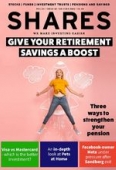Archived article
Please note that tax, investment, pension and ISA rules can change and the information and any views contained in this article may now be inaccurate.
Why retail’s squeezed middle could really struggle in the months to come

The announcement that every household is to receive £400 off their energy bills in the autumn coupled with a comprehensive package of support for pensioners and those on benefits immediately resonated with investors and shares in retailers shot up.
But the resurgence was short-lived, the consensus being there are just too many challenges facing the sector, with consumers on both sides of the Atlantic simply too constrained by budgetary pressures.
The latest Opinions and Lifestyle survey conducted for the Office for National Statistics found that 56% of people were spending less on non-essential purchases.
Business after business has hit the profit alarm from US mega-store Target (TGT:NYSE) to UK high street stalwart Marks & Spencer (MKS). Sales have been robust, even rosy, through the first part of the year as pandemic restrictions finally fell away but inflation has sent jitters through boardrooms.
Next (NXT), Primark-owner Associated British Foods (ABF), and online fast fashion business Boohoo (BOO:AIM) have all warned prices will have to rise – a particular anathema to businesses chasing value-driven shoppers.
Brands that had already been struggling like Ted Baker (TED) and Missguided have either had to hoist the for-sale sign or appoint administrators. And with a number of high-profile bosses heading out various doors – from B&M European Value Retail (BME) to Pets at Home (PETS) – it adds an extra frisson of uncertainty.
A TALE OF TWO CUSTOMERS
But not all retailers are the same and, in this case, investors might want to consider the customer rather than business model.
Upbeat profit forecasts from luxury retailers have highlighted the disparity between more and less affluent consumers. The deep pockets of the customer base shared by London-listed Burberry (BRBY) and its US compatriots Nordstrom (JWN:NYSE) and Ralph Lauren (RL:NYSE) deliver a designer cushion against price pressures.
While decades-high inflation is forcing most consumers to cut back, those with higher incomes are, at least for the moment, proving more resilient. All have commented that, so far, they’ve been able to hike prices without seeing any kind of major push back from customers.
That pricing power is enabling high-end brands to avoid the discounting spiral that other retailers have fallen into headlong as they try and clear out stock gathering dust on backroom shelves.
Up until now lockdowns in the lucrative Chinese market may have given investors pause, but as restrictions are lifted it seems many are taking a long look at the distinctions between retailers.
However, even in the case of high-end US department store Nordstrom, which has rallied considerably over the last month, its valuation is still subdued compared to its pre-pandemic levels.
Retailers, particularly bricks and mortar stores, have had it tough over the last couple of years, something that makes the predicament faced by more mainstream businesses even more difficult to deal with.
There may have been some expectation that value names like Target and B&M might also have benefited from the inflationary environment as customers looked to trade down in search of cheaper deals.
COMPETITION IN THE SUPERMARKET SECTOR
Certainly, that’s the way it is going in the UK’s competitive supermarket sector with discounters pulling market share from middle of the road stores, in particular Morrisons. But when margins are wafer-thin and supply chains are still sluggish, profit becomes harder and harder to generate.
This inflationary spike is unprecedented, and the shifting sands of geopolitical instability make it harder than ever for investors to get a grip on what’s coming down the tracks. If high end retail is expected to cruise through the inflationary storm and value to be buffeted by both head and tailwinds, what of those middle of the road, multi-channel operators like Next?
Often seen as a bellwether for the retail space it was one of the first to sound a cautionary note. Will it end up adrift or will its mix of products, brands and prices coupled with its credit option make a difference and provide a way through increasingly choppy waters?
Latest figures from the Bank of England suggest shoppers have been hammering their credit and store cards and retail sales figures last month saw a surprising uptick in clothing purchases as people prepared for a summer of delayed celebrations and sunshine holidays. But every month seems to bring another bill hike and by the time Christmas comes around the worst of those energy price increases will haven taken hold.
What’s true in the first six months of the year is unlikely to change significantly over the next six months. Those for whom money isn’t really an issue will continue to spend and the retailers that enjoy their patronage could continue to outperform.
Important information:
These articles are provided by Shares magazine which is published by AJ Bell Media, a part of AJ Bell. Shares is not written by AJ Bell.
Shares is provided for your general information and use and is not a personal recommendation to invest. It is not intended to be relied upon by you in making or not making any investment decisions. The investments referred to in these articles will not be suitable for all investors. If in doubt please seek appropriate independent financial advice.
Investors acting on the information in these articles do so at their own risk and AJ Bell Media and its staff do not accept liability for losses suffered by investors as a result of their investment decisions.
Issue contents
Editor's View
Feature
Great Ideas
Investment Trusts
News
- Tesla and Microsoft give investors fresh reasons to fret
- Why boot brand Dr. Martens is walking tall by delivering growth
- Why the timing of Sandberg’s exit from Meta is terrible given severe challenges
- What the latest FTSE reshuffle means for the UK's leading shares
- Is it finally time to take a proper look at the Chinese market?

 magazine
magazine








